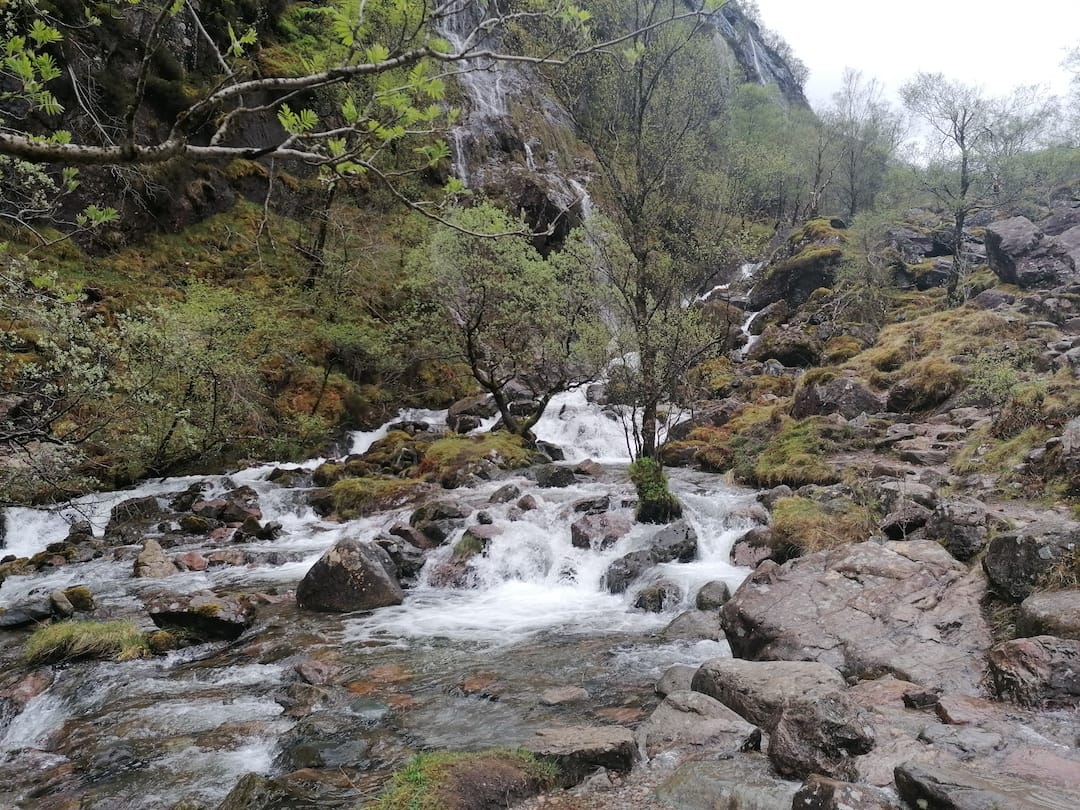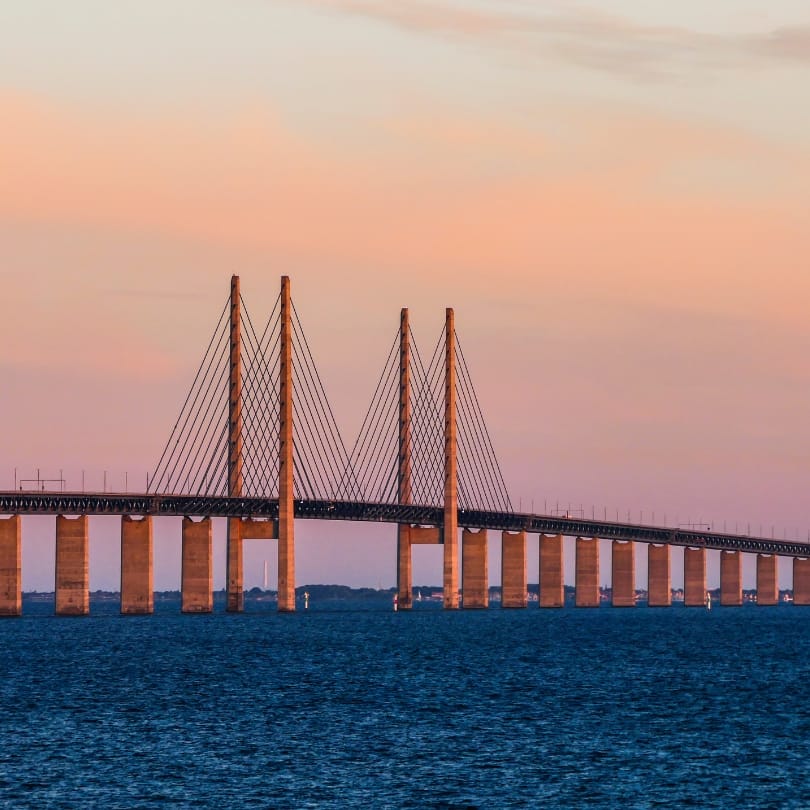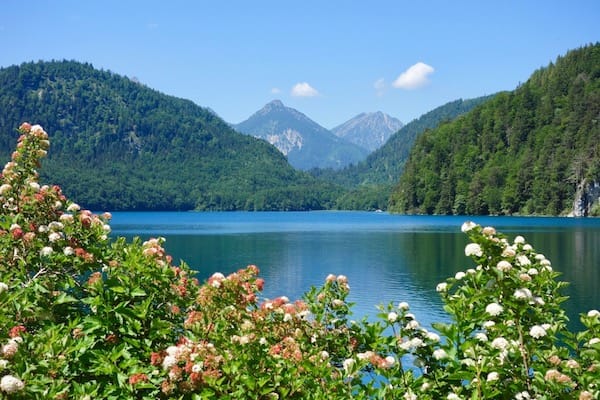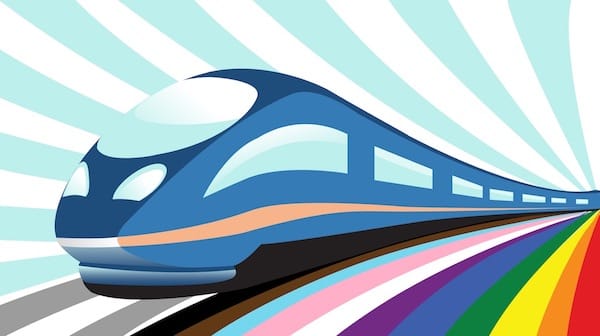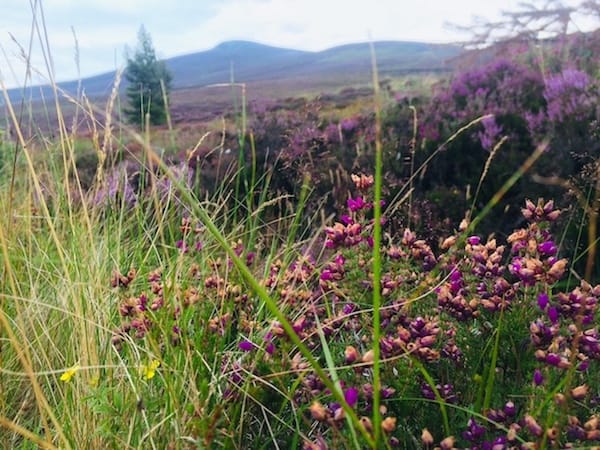
Day 1: Harrogate to Loch Lomond
230 miles
Depending on where you’re starting from, the journey to Scotland can be long! Think about your timeframe, be realistic and be safe. We set off from Harrogate in North Yorkshire and were confident that we could reach Loch Lomond the same day, but you could stop off in the gorgeous Lake District on the way, or stay in a city like Glasgow or Edinburgh, which is also a great shout if you want to stock up on anything before getting into more remote areas.
We made a beeline for Milarrochy Bay on the eastern side of the loch, which was a dream place to park up. The car park is huge with great views, and there are lots of lovely walks nestled within lush forests. It’s also a great spot if you want to kayak, paddle board or swim.
An added bonus which all ‘vanlifers’ will appreciate is that the toilets are very spacious, there’s hot running water and the disabled toilet is left unlocked overnight so you always have access, which as we know is incredibly handy when on the road!
Sleep: free parking at Milarrochy Bay, Loch Lomond
Tip: Download the ‘Park4Night’ app to read and leave peer-to-peer reviews about great parking spots for a restful and unbothered night’s sleep in your campervan. It’s an absolute must if you’re planning on finding nice spots to camp in, while remaining respectful of the beautiful environment.
Day 2: Loch Lomond to Oban
90 miles
It’s important to break up the day with rest stops, and our first stop was Firkin Point, about halfway up Loch Lomond on the western side. To get there, we had to drive around a large part of Loch Lomond, giving us our first taste of scenic driving in Scotland. The main road (A82) goes right next to the loch, so there are incredible views of the water and across to the mountains on the other side.
Firkin Point is a popular place for dog walkers but is otherwise generally quiet, so it’s a great place to have a nice swim. We found a good spot to have a super quick, cold dip, then warmed up on the shores and cooked something to eat while we waited for our things to dry before getting on the road again.
The next stopping point was the Falls of Falloch, again, off the A82, about four miles north of Loch Lomond. It’s an amazing waterfall on the river Falloch (the main river that flows into Loch Lomond) and there’s a large car park to accommodate the crowds. We watched a couple of brave people jumping in from a height but we were happy to be bystanders; that water must’ve been freezing!
Tip: When visiting waterfalls around Scotland, definitely go after it’s been raining (quite often then!) as they will be gushing with water which makes them really powerful and wonderful to watch. It will definitely add to the magic of your trip.
Falls of Falloch to Oban was about an hour along the A82 and A85. The roads around here are generally brilliant and well-appointed: spacious and smooth, winding gently through incredible scenery and beautiful craggy landscapes. There was hardly any traffic as we’d picked a quiet time of year and avoided rush hour, so we were able to get from A-B very quickly and stick to the timings on our plan with great accuracy.
Oban is one of the busier areas we visited on this trip. It’s a bustling fishing town with plenty of shops, cafes and restaurants near the waterfront, and of course lots of fresh local seafood. There was everything you could need close by, including large supermarkets, hardware stores and a Homebase which can be handy in case you need anything specific for your trip. Oban is clearly a hub of activity, which makes for a brilliant place to pass through, as well as a gorgeous destination in its own right.
Once we arrived in Oban we took ourselves for a casual jaunt around the town, then walked up to McCaig’s Tower, the large circular fort that overlooks the town from near the top of the hill. It’s well worth the climb for the peace and solitude as well as the incredible view over Oban Bay, and we were treated to the most striking pink sunset.
Sleep: car park.
We stayed in the Rugby Club car park which was not exactly glamorous but it was quiet and safe nestled near residential roads, and only a short away from the main town.
Day 3: Oban to Isle of Mull
20 miles
Tip: If you’re travelling as a foot passenger, you don’t need to worry too much about grabbing a space on the ferry, but if you’re taking your campervan to the Isle of Mull, it’s much less stressful to book your place on the ferry the day before, and work out where to drive in at the port. We also rang the campsite the day before to make sure they had space.
The ferry to Mull was huge! We made sure to take advantage of the spacious top deck, which has the best views. The seats were set out in a triangle which gave an awesome view from wherever you were; a simple but effective way to make the journey even more enjoyable. It was pretty windy out on deck though, so it’s good to remember a head band or scarf and chapstick, and binoculars if you can, to see wildlife up close and nosey in on things jutting out of the water.
Mull is a beautiful island with lots of wildlife, gorgeous single track roads and some fabulous beaches. It was also wonderfully quiet when we were there. Being the first week of May we thought it might be busier, but other than a few other tourists, it was nice and peaceful with clear roads, which is great for a road trip! We had a distinct feeling of remoteness and escapism as soon as we arrived on the island, which is exactly what we needed.
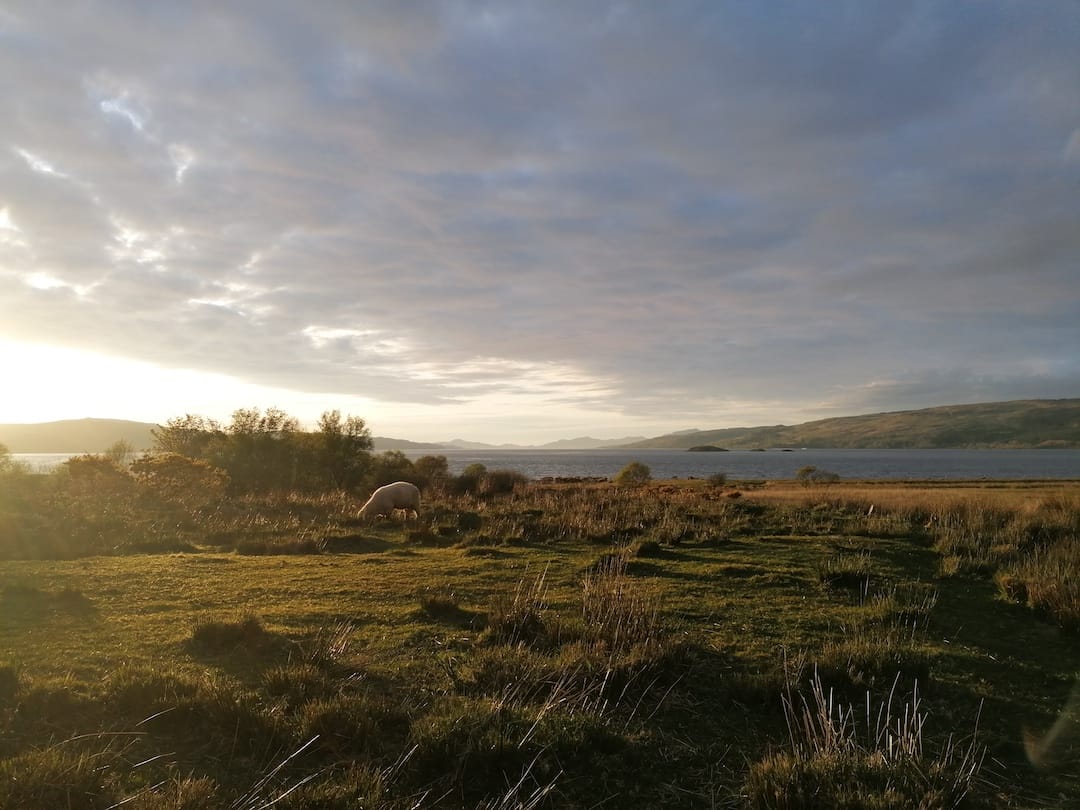
Sleep: Pennygown Holiday Park.
You’re not meant to wild camp on the Isle of Mull, and being fully respectful of Scotland’s nature and conservation efforts, we booked a van pitch for two nights at £25 a night. On our first evening we were privy to another glorious sunset with a full end-to-end rainbow… talk about a magical place! It was an incredible place to sleep.
Tip: Staying in a campsite is a good thing to do halfway through a road trip to enjoy a warm shower, wash your pans properly and catch up with laundry if you need to. We didn’t actually need to do anything other than shower at this point, but it’s great to have the option. The owner also tipped us off on a scenic route we might not have found out about!
Day 4: Staffa and Iona
45 miles out/40 miles back
We took the main route (A849) around the south part of the island, heading to Fionnphort to get the ferry to Iona. It’s a fair drive along single-track roads, so we allowed ourselves plenty of time.
Tip: Research driving on the Isle of Mull to understand the road signs, the etiquette and the rules. Remember that this is not just a holiday destination but locals live here too. The main rule is, on single track roads, use the passing places to pull over to let approaching cars pass, or to let cars behind pass you. You should only ever go to the left, watch out for wildlife, and never park in these passing places.
We parked up for the day at Fionnphort then boarded the ferry: first stop, Staffa, where we visited the famous Fingal’s Cave. Fingal’s Cave is absolutely breathtaking. It’s a sea cave formed entirely from hexagonal columns, similar in structure to the Giant’s Causeway in Northern Ireland. We’ve never seen anything like it; it’s like something out of a fantasy film. The island is inhabited only by wildlife and it’s absolutely magical.
We had plenty of time in the afternoon to explore the quiet Isle of Iona. In Scotland it feels like time slows down; in the best way possible you get to enjoy so much every single day. Somehow we fit a lot in each day, while taking our time with all of it.
On Iona we found ourselves on perfect white sand beaches, and scrambled (the wrong way) up to the highest point of the island, Dun I (pronounced dun ee) which means 'hill of Iona'. The official path is up the road past the Abbey, following the signs. Instead, we went through some very boggy land and up a pretty steep hillside, disturbing some rams protecting their lambs and needing a fair amount of effort and good shoes. Sometimes a wrong turn makes a good story! Dun I is only 100m above sea level but the view from the top is gorgeous.
Once back on Mull we took a different route back to the campsite, as recommended by the campsite owner. It took us along the very narrow, winding B road alongside Loch Scridain next to the only Munro on the island, Ben More (‘big hill’ in Scottish Gaelic) – definitely one to climb next time.
We then followed the banks of the spectacular Loch na Keal. This has to be one of our favourite moments of the trip; we saw deer, owls, birds of prey, cattle, horses and lots of sweet little lambs. This road is long and windy, and seemingly endless. At one point, we thought it was never going to end (and we didn’t want it to either!) Just when you thought it might all be over, we’d round another corner and something else magnificent would come into view. The water and misty air made it epic in every sense of the word. This could be one of the best and most memorable scenic roads I’ve ever travelled on.
Day 5: Isle of Mull to Dallachulish
46 miles
With an evening ferry booked, we could spend a bit more time exploring Mull, so we headed to the northern part of the island, towards Tobermory. We visited the beautiful cows and gorgeous glass house cafe at the Isle of Mull Cheese farm, before heading over to stroll along the famous waterfront at Tobermory. We’re not one for souvenirs but after Charlie fell in love with the puffins in Staffa and as we only had one mug in the van, we’d been keeping an eye out for the perfect puffin mug, and it was here we found a beautiful tin one.
Tip: If you’re looking for tourist stuff, you’ll find it here. There’s a mixture of independent shops, local artists’ work and some fun tourist stuff, so there is something for all.
The evening ferry was spectacular with an amazing light falling on the water, and after arriving back on the mainland we drove a little way north to find a spot to park up for the night. If you like bridges, this is your chance to drive over the remarkable Connel Bridge.
Sleep: lay-by at Loch Creran
We rested up on the A828, a wonderfully quiet road with several spacious lay-bys. It was pitch black right next to a beautiful loch with only the sounds of owls and leaves rustling in the wind.
Day 6: Dallachulish to Glen Coe
26 miles
After a morning coffee at Castle Stalker view (a lovely cafe on the A828) we parked up at the Glen Coe Visitor Centre, near to Glencoe village. It was a great place to start our exploration of the area: we learned about the infamous massacre and how mountain climbing in Scotland has developed over the decades. The building itself is lovely, and if you need to do any research or catch up with anything online, there is a space to plug in, charge up and do whatever you need to do.
Tip: There is a free tour of the turf house which offers super detailed information about how people from the 17th Century might have lived, giving us a much richer sense of the land and the area’s history.
Once we had decided which walks we wanted to do, we set off for the epic drive through Glen Coe along the A82. This road has been described as having some of the most spectacular views in Europe and it definitely does! There’s loads to see including a turn off through Glen Etive, which was the filming location for James Bond’s Skyfall. The single-track road follows the river, with long thin waterfalls coming off the tall rocks. It was a magical feeling like no other – we felt like we were being transported to another place!
Tip: If you love swimming, once you’ve ironed out your plan, mark up the swimming spots in each area so that depending on the day, you will always know whether there’s somewhere to swim if you have time. Doing this beforehand saves you loads of time, stress and filters out the need for the internet, which you might not have access to on the road.
Most of the time we stuck to our itinerary probably because we kept things loose and allowed for plenty of time to stray off and add things in during the days, which meant on the road we didn’t waste time on our phones working out what we were doing or how to get somewhere.
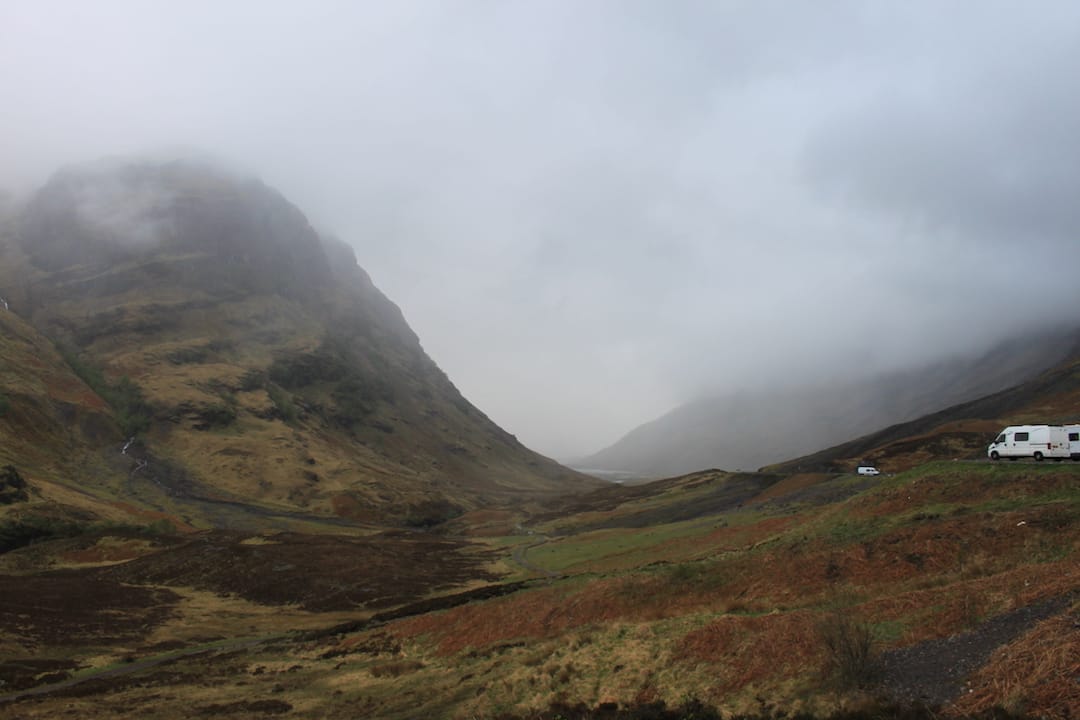
However, things don’t always go to plan, and though we had intended to head to Fort William that night, we were busy saving a lost dog.
The poor thing had clearly lost its owners and was in distress – we couldn’t leave her in the car park alone. So we found out her name, befriended her, and after a time, she decided we were cool.
Time went on, it started to rain and darkness fell, and we were starting to worry about what to do. But good news: the owners returned. Recognising a super stressed and tired-looking couple from a distance, I shouted to the two weary souls to check if they’d lost a dog. With fresh hope in their eyes, they looked at me and the dog’s tail picked up.
A happy ending for all involved. We went back to the van but it was too late, too wet and too dark to hike or drive somewhere else so we decided to stay overnight in the Three Sisters car park.
Sleep: Three Sisters Viewpoint car park, Glen Coe
Day 7: Glen Coe to Glenfinnan
40 miles
Our unexpected overnight stop turned out to be perfect, as we could start the morning with the Lost Valley walk, a two-mile hike down a nearby gulley, which was absolutely incredible! It involved a funky river crossing which was exciting but not for the faint-hearted as the water was running fast…
After the river, it’s not far to reach the valley, but it is quite steep. It’s 100% worth it. As some of the first people of the day we got to enjoy it pretty much to ourselves. We find we always experience a place differently if there are loads of people compared to when there are none or very few.
Tip: Go early if you can. We were definitely one of the firsts of the day to do it, and we are so glad, as on the way back around 11am, we noticed lots more people doing the same journey we’d just completed.
After the walk we were in a bit of a rush because we wanted to see the Harry Potter steam train go over the Glenfinnan Viaduct, which we’d been advised would be around 2.30-3pm.
When we arrived, the car park attendant let us know that it wouldn’t pass until 3.20pm, so we had time to get some lunch and go round to the hill on the other side of the viaduct, rather than be in the same place as the crowds. We were the first to get there so managed to grab the best spot (it’s very clear where it is) before a few others also turned up later. We felt very smug having grabbed the best seat in the house!
Now, a road trip would not be complete without some mechanical trouble, would it? Vehicles aren’t allowed to stay in the Glenfinnan Viaduct car park overnight, but when we got back to the van and tried to start the engine, we found that the fan belt had fallen off! We knew we were lucky that this happened right at the end of the trip; we’d done everything we’d aimed to do and it’s a wonder nothing had happened with this old van earlier. We arranged to be towed in the morning to the garage, and stayed overnight in the car park with no issue.
Tip: We saw a warning light before getting to the viaduct so knew something would happen. With only a few miles to go, we deliberately drove somewhere we knew would be well equipped, rather than risking breaking down in the middle of nowhere. Having foresight and being sensible can turn a potentially big problem into a much smaller, less stressful one.
Rather than sit in the van for hours, we found a nearby place to have a lovely dinner. We were just in time for last orders at the beautiful Glenfinnan Hotel, and were once again treated to the best seats in the house, watching deer along the lawn with a backdrop of the amazing water and Glenfinnan Monument.
Dinner at the hotel was another perfect moment; if Scotland is always like this, I’d like to move here!
Day 8: Fort William to Harrogate
330 miles
With the van fixed by midday, we set out for the long drive back to England, bringing an end to our beautiful and epic Scottish adventure. We had an amazing time, and we'd definitely do it again. I feel much more connected to the UK now, having seen more of it.
Many of us are brought up with romantic narratives about road tripping around America, or the distant corners of Europe. We see movies and fall in love with places thousands of miles away, convinced we must get to them. And while these trips would be fun, why don’t we consider a local road trip around Scotland, England or Wales first? These countries are also incredibly beautiful with stunning scenery, coastlines and wildlife, yet we dismiss them all too readily. It’s bizarre when you think about it.
It’s obvious that we have to fly less, but that's not a bad thing; it means we appreciate what’s around us and become so much more engaged with our local areas.
A road trip in Scotland is a great flight-free trip and I recommend it whole-heartedly.
